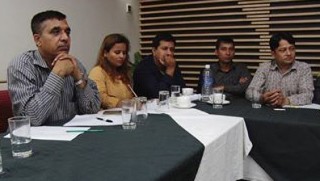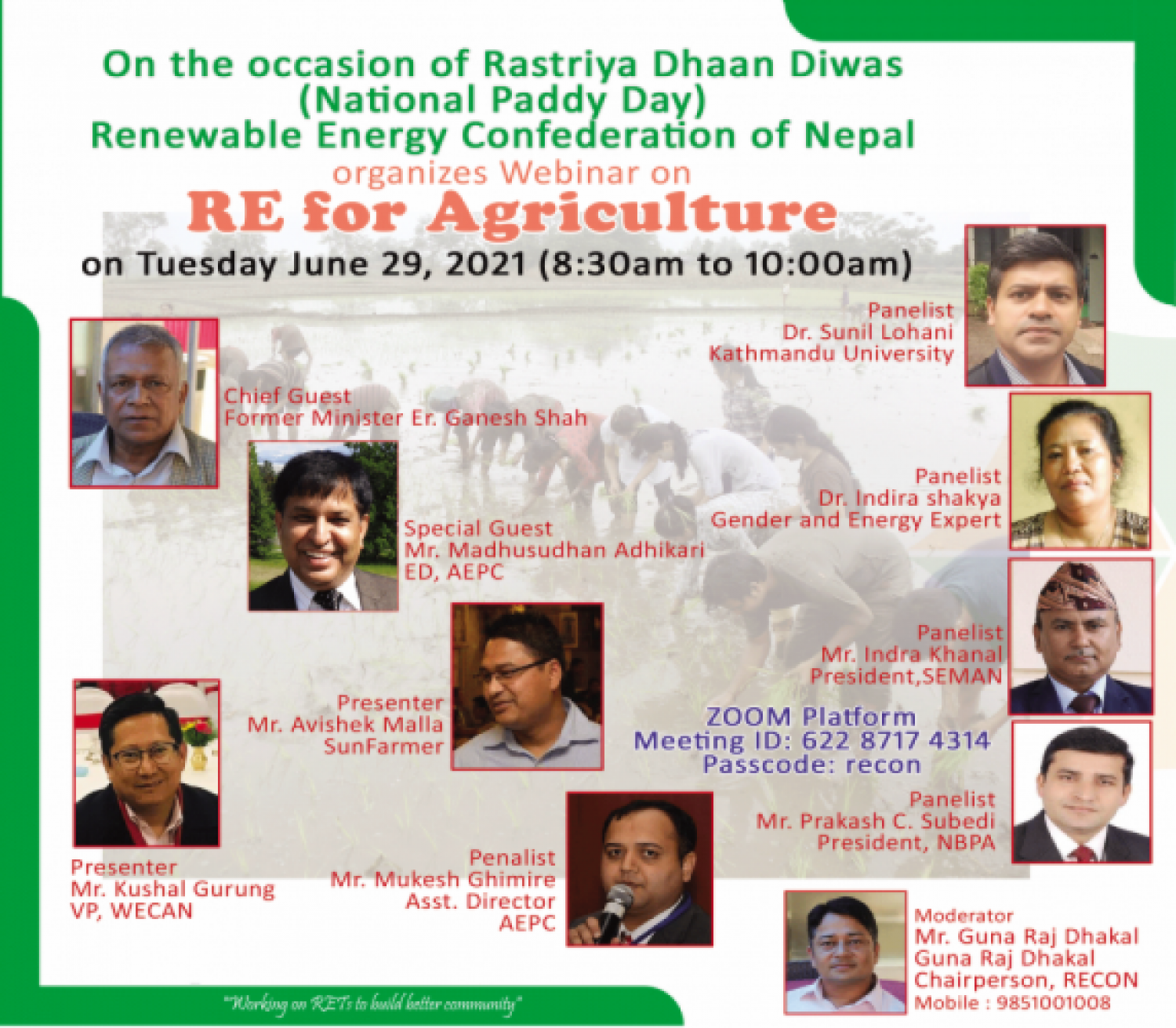
On Saturday July 01, 2017, Kathmandu
- Organised by Renewable Energy Coordination Committee
- Facilitated by Former Minister Er. Ganesh Shah
- Presentation by Mr. Bhushan Tuladhar
- Prsentation by Mr. Suman Shakya
- Coordinated by Mr. Guna Raj Dhakal
- Managed by Mr. Purna N. Ranjitkar
Rainwater harvest in Nepal: a wiser way to be ensured on water
Water is our most precious natural resource and something that most of us take for granted. We are now increasingly becoming aware of the importance of water to our survival and its limited supply.
The harvesting of rainwater simply involves the collection of water from surfaces on which rain falls, and subsequently storing this water for later use. Normally water is collected from the roofs of buildings and stored in rainwater tanks. Water can also be collected in dams from rain falling on the ground and producing runoff.
Either way, the water collected can be considered to be precious.
Rainwater harvesting techniques
The collection of rainwater from the roofs of buildings can easily take place within our cities and towns, not just in rural areas. All that is necessary to capture this water is to direct the flow of rainwater from roof gutters to a rainwater storage tank. By doing this, water can be collected and used for various uses.
If you are reliant on collected rainwater and are not connected to a town water supply, then the water collected will be especially important to you. If you are from the city, then it is possible to replace all or at least a substantial portion of fresh water requirements by the capture and storage of rainwater from roof. Being largely self sufficient in water supply is possible for a vast majority of households and buildings.
The benefits of rainwater harvesting projects in Nepal
Rainwater harvesting projects do not only provide water for drinking, but also for washing, kitchen gardening and biogas production. But there are more advantages than healthy livelihoods alone.
- When people use retained water in dry periods, the soil will regenerate and conserve the landscape, benefitting the environment.
- Combining different rainwater harvesting systems can generate more crops and because of that, a high income may be possible.
- Using credit facilities to sustainably finance rainwater harvesting projects, enables farmers to repay their loans and create local ownership.
The rainy season is when the water supply is good, why should not harvest rainwater?
Three reasons are:
1) This is not always the case and becoming increasingly less so. The current demand for water is 320 Million litres per day while the supply is only 120 Million litres a day in the Monsoon. In 2002 the demand was 140 Million litres a day; every day the water situation becomes worse for somebody even in the monsoon, tomorrow that person could be some of us. More than 15% of Kathmandu’s population purchases trucks of water year round, meaning they spend more than 30,000 rupees a year on water.
2) Convenience; More than half of the people have to get up between 12 and 6 a.m. to deal with water, even during the monsoon. If you use the storage tank in your house to collect rainwater this inconvenience is avoided. Additionally the occasional sewage leaks that affect municipal supply, especially during the monsoon, will no longer be a problem during this time.
3) Groundwater - Most people we talked too used to have abundant water in their tube wells 15 years ago, but do not today. Why? Over pumping - No. The main problem is that the rain that used to go into the groundwater is now sent to the sewer. More rainwater inside the Ring Road is sent to the sewer than the much-hyped Melamchi will provide within this year. This figure was half 15 years ago. Before this water used to percolate into the ground and much of it remained for dry season consumption, this is no longer the case. The available technologies and experts can work help recharging this “wasted” rainwater into your well.
Moreover, the Kathmandu Valley may be taken as an instance which receives 1600 millimetres of rain every year. This means that on a typical rooftop of 100 square meters more than 160,000 litres of rain is available for capture and use. Municipal water supply is becoming increasingly inadequate, water quality questionable, and serves under half the demand in Kathmandu. Tanker water trucks are expensive and water quality questionable. Groundwater levels are depleting and quality is becoming increasingly worse. Thus, this is to be noted that the much waited Melamchi water will come to the capital valley surely but with some reasons the users will still have to spend water wisely and look for rain water as a backup.
As harvest rainwater is to save water, save money, and recharge wells improving both the groundwater quality and quantity the available technologies and expertise should be utilised at maximum level so as water scarcity can be addressed in time, before getting to the worst situation.
Opening with remarks by Former Minister Er. Ganesh Shah
Opening the interaction programme Former Minister for Science and technology and Environment Er. Ganesh Shah said the water problem in country is needed to discuss and understand the facts behind water scarcity and remedies.
The water is an important component for all for any reasons as such experts and knowledgeable experts are requested to lend knowledge and experience. The rainwater harvest is simple technology and cost effective as well therefore wise use of rainwater is desirable to overcome water scarcity. So as some or many water uses may be possible to tackle efficiently.
Presentation by Mr. Bhushan Tuladhar
Through a PowerPoint presentation Environment expert Mr. Bhushan Tuladhar elaborated the water recharging systems in Kathmandu Valley. The old civilisation and culture had given enough space to water and maintaining the water sources and channels. But rapid urbanisation had enchroached many such creations of the past. The Kathmandu Valley people are now waiting Melamchi water to arrive for better living with drinking and other purposes related to health and sanitation.
He had indicated that rainwater harvest is still an easy solution for the Kathmandu Valley and rest of the places in the country.
Rainwater harvesting is a simple technology which can be applied very easily at comfortable cost. He also explained that rainwater can be used for drinking and all other waterly purposes. This technology will be useful even after arrival of Melamchi water in the Kathmandu Valley as Melamchi water and existing supplies will not meet the minimum demand of water.
Presentation by Mr. Suman Shakya
Mr. Suman Shakya has a good deal of experience in equipments and technology of rainwater harvest to his clientele. He and his company SmartPani had earned enough fame for the well performance in the rainwater harvest.
Mr. Shakya elaborated the drinking situation in The Kathmandu Valley and other place through a Power Point presentation. Elaborating the system available, he said that water problem could be solved for the households by using collected rainwater. He also said that the technology is simple and easy, and they require simple techniques and efforts to maintain.
The water bottling companies may use rainwater for better business opportunities, he added.
Discussions participated in by
Ms. Sarmila Rayamajhi, Dr. Hari Vinwar, Mr. Purak Adhikari, Mr. Gunjan Khanal, Dr. Tek Bahadur Gurung, Dr. Shree Bhagvan Thakur, Dr. Manish Pokhrel, Mr. Sudarshan Sigdel and Mr. Yug Ratna Tamrakar participated in the discussions. They put questions on implementation of the technology of rainwater harvest for particular domestic and institutional uses.
The discussions were focused on use of the technology in the households, water for the biogas plants, water for using in large size buildings, land area and transport companies and water bottling industries.
Presenters Mr. Bhushan Tuladhar and Mr. Suman Shakya and facilitator Former Minister Ganesh Shah responded the queries.
Concluding remarks
Coordinator of RECC Mr. Guna Raj Dhakal appreciating the useful and informatics presentations by Mr. Tuladhar and Mr. Shakya thanked to the participants from the academia and expertise to make the interaction programme successful. The queries and comments were encouraging and useful for enhancing the movements toward wider use of the technology, he added.
The outcome of the presentations and discussion will be put forward for necessary actions by appropriate authorities, Mr. Dhakal told on the occasion.




